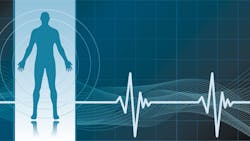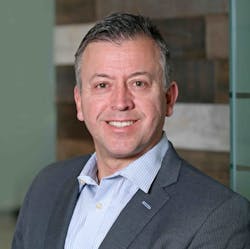Soothing pain points in patient monitoring techniques, technologies
Against the backdrop of swirling healthcare industry pressures over the years, from the expansion and growth of diseases and viruses to the budgetary speedbumps of economic planning to intensifying clinician anxieties, job fatigue and labor shortages, patient monitoring technology advancements largely have kept pace, bobbing and weaving through increased demands for more bells and whistles.
In fact, patient monitoring devices today track a host of internal patient vital signs as well as external patient motion with data accuracy and acuity. Further, patient monitoring devices have evolved and progressed beyond the bulky machines of yesteryear to embrace convenience and convergence via handheld scanners, ingestible cameras and skin-adhering and wearable sensors from wired to wireless that include smartphone apps and smartwatches.
Patient monitoring devices also have gone remote in several ways – from bedside platforms to central nursing stations on patient floors to different floors within a facility. Urban and suburban facilities also can operate patient monitoring devices located in rural areas and home-based settings. One of the latest benefits sees the remote monitoring of patient monitoring devices themselves by device manufacturers tracking for optimal device operation with the ability to diagnose and repair issues from afar, thereby minimizing downtime, if not eliminating it altogether.
Short of achieving the mythical, science fiction-based tricorder in “Star Trek,” you might think patient monitoring technology may have reached the relative pinnacle of the modern age. Yet, clinicians and administrators still yearn for more. The latest among the lingering pain points encompasses the efficient collection and transmission of data in a connected world threatened by cybersecurity concerns as well as the wonder and wariness surrounding artificial intelligence (AI).
The bottom line: Patient monitoring devices may gather and generate a wealth of data, but that data has to migrate to and populate other systems beyond the electronic medical/patient record, including accounts payable/billing, financial and to a degree, supply chain.
Pain points linger
While clinicians may be fortified with some of the latest technology available – or that budgets allow – they still face a few pain points that span capacity as well as process and procedures.
“There are two main challenges that clinicians are dealing with that converge to create an opportunity to streamline patient monitoring workflows,” Paine told Healthcare Purchasing News. “The first is that collecting and documenting vital signs data can be a burden on the care team. The process is manual, takes extra time and is prone to transcription errors. Manually collecting vitals data also can result in delays or limitations to the information available to the broader care team.
“The second challenge is that the healthcare environment is more challenging,” he continued, “with a shortage of nursing and patient care technicians and higher patient volumes, with patients who are sicker than before – clinicians on medical/surgical floors are commonly caring for up to 10 patients during their shift. There is an opportunity here for automation, to help direct nursing and technician resources to direct patient care, where they can have the greatest impact to meet the facility’s quality goals.”
The first involves nursing shortages. “Many healthcare facilities experience a shortage of qualified nursing staff, which can affect the frequency and accuracy of patient monitoring,” Mann noted. “This shortage may result in delayed responses to alarms and patient emergencies.”
This can lead to the second, which is alarm fatigue. “Traditional monitoring systems may generate numerous false alarms, leading to alarm fatigue among clinicians,” he said. “When clinicians become desensitized to alarms due to excessive false alerts, they might miss genuinely critical alarms.”
Access to real-time data rounds out the trio. “Clinicians need real-time access to patient data to make informed decisions promptly,” Mann insisted. “If the monitoring systems are not equipped with wireless connectivity or continuous monitoring capabilities, it may lead to delays in identifying critical changes in a patient's condition.”
“The challenges clinicians experience with patient monitoring technologies in these types of high-acuity environments center around the ability to understand when to escalate and when it’s safe to de-escalate care, as well as achieve the elusive balance between individualized and standardized care across a unit,” he noted. “This is due to the data overload from numerous patient monitoring devices, difficulties in achieving a unified view of the patient condition among the care team, and the cognitive burden it places on care team members to interpret the data vs. being more immediately actionable.
“Any clinician would tell you that you can't make a decision on a single data point or parameter, which is often the extent of what’s provided from conventional hardware-based monitoring,” Butler continued. “You need to understand the context, evolution and interactions of multiple parameters, which is what the right software platform can provide.”
“Many clinicians are concerned about capacity and effectively managing their highest risk patients between visits,” he indicated. “While busy taking care of patients in the office and trying to manage patients’ complex needs and care coordination out of the office, clinicians can be overwhelmed.”
That’s why clinicians need to carefully assess their remote patient monitoring (RPM) capabilities and connectivity, according to Casamassa.
“It is important to note that some RPM platforms are standalone and are not integrated with the clinician’s electric medical record (EMR),” he said. “Practitioners may not want to work in multiple systems to collect, collate and analyze information that should be readily available in their EMR, so it is recommended to use a single platform versus multiple to manage a patient population. To best utilize these or other RPM platforms, it is important that information can be collected, collated and analyzed through an EMR. This information should also be contextualized or associated with other critical information, such as demographics, medications, lab values etc.”
Casamassa references a clinical study, titled “Reducing Physicians’ Cognitive Load During Chart Review: A Problem-Oriented Summary of the Patient Electronic Record,” as an indicator. (See https://pubmed.ncbi.nlm.nih.gov/35308927/#full-view-affiliation-1)
“Studies have shown that when data is presented in a disease-centric view and contextualized with other critical information, it can help reduce cognitive fatigue,” he noted. “This is relevant to RPM because clinicians need the clinical context in order to interpret and act on the RPM data. Given the current staffing shortage with both primary care providers and nurses, clinicians recognize the need to leverage technology to effectively manage multiple patients at a time.”
Casamassa cites other clinician concerns that revolve around patient onboarding, patient compliance, device management and reimbursement – specifically how to maximize payments or incentives within fee-for-service (FFS) or value-based care (VBC) models for which Henry Schein’s RPM platforms support both, he added.
“First, the staffing shortages and cost constraints limit the frequency of patient visits by staff,” Drysch said. “That leaves patients unattended for long periods of time. Having a device that can immediately alert the staff of a patient fall, unauthorized visitors, violent behavior or the patient leaving the room is critical. And it needs to be done in an inexpensive and unobtrusive way. No one wants to wear lots of sensors, nor do they want a camera in their room invading their privacy.”
Supply Chain’s role
Patient monitoring technology company executives concur that supply chain managers can and should help clinicians surpass the short-term operational hurdles they face so that they don’t morph into long-term challenges.
For Baxter’s Paine, the answer rests in assembling a team and reverse-engineering the process.
“Supply chain leaders can help by bringing together a cross-functional team – commonly stakeholders from clinical, IT, informatics and biomedical engineering – to identify the best opportunities to streamline monitoring workflows,” he said. “It starts by looking at the process, starting from the first point of contact in the emergency department up to the medical/surgical floors and following the patient throughout their care journey. Supply chain leaders are well equipped to spot the areas of inefficiencies and work with the clinical team to find where monitoring automation can remove manual tasks and information delays that can occur in every department in the hospital.
“The other focus area for supply chain leaders is to work closely with IT to develop a ‘connectivity first’ mindset,” Paine continued. “Sometimes, we see connectivity fall to the bottom of the priority list. The real efficiencies in patient monitoring come when the monitor is connected to the hospital EHR, care communications platforms and other clinical applications. Once connectivity is prioritized, it opens up a variety of untapped potential for automation and analytics.”
Caretaker Medical’s Mann recognizes that supply chain can play a crucial role in assisting clinicians in two key areas.
The first is technology selection. “Supply chain partners can ensure that cutting-edge technologies are readily available and accessible to healthcare facilities,” he said. “This includes selecting robust and user-friendly devices that can seamlessly integrate with existing systems.”
The second is continuous improvement. “By fostering a collaborative relationship, the supply chain can facilitate feedback loops between clinicians and Caretaker Medical,” Mann indicated. “This feedback can be used to make continuous improvements, addressing any pain points and refining features for optimal usability.”
Travel plays a key role, too, Mann insists, primarily conferences and trade shows to visit technology exhibitors together.
“Supply Chain, along with clinical nursing, should attend conferences and trade shows to evaluate emerging patient monitoring technologies,” he recommended. “By participating in conferences, value analysis can gather broad based information and make informed decisions that not only meet immediate needs but also contribute to improving patient outcomes, enhancing clinician efficiency and optimizing resource utilization in the years to come.”
Mann advises clinicians to partner with supply chain and value analysis to collaborate on exploration, sourcing and selection so that they can learn from each other.
“At Caretaker Medical, we are partnering with hospitals where Supply Chain and clinical nursing are already working hand in hand, and have recognized the mutual benefits of collaboration,” he noted. “Working closely with clinical nursing allows Supply Chain to gain crucial insights into the frontline needs of healthcare professionals and patients. Through this collaboration, they can pinpoint areas that require improvement and find technology solutions that best meet their evolving needs.”
Etiometry’s Butler offers a blunt assessment of the motivation behind contemporary patient monitoring technology, one critically tied to the perspective of the customer.
“The bottom line is that patient monitoring technology needs to address the realities of a stressful, often short-staffed environment with high turnover,” he said. “If it doesn’t make the clinician workflow easier, it won’t be used.”
The Etiometry platform was built by clinicians for clinicians more than a decade ago to specifically address challenges in patient monitoring technology within critical care, according to Butler.
“Initially, the data overload issue was addressed by aggregating all available patient data from monitors, the EHR, etc., onto one screen to inform efficient treatment decisions,” he continued. “This more easily enables the care team to share a mental model in terms of the patient condition, which allows for a more consistent care strategy throughout their ICU stay. As a data driven storyboard, the platform allows individual clinicians to back up their gut feeling and advocate for their patients to the broader care team, acting as a tool for objective communication.”
Clinicians need to determine whether the patient monitoring devices they’re using are more tuned to research than active caregiving, Butler indicates.
“Many data aggregation solutions are built to pull up data retrospectively for research or quality – and not to aid in decisions at the bedside,” he said. “Make sure the software you choose is accessible at the bedside, remotely and within an ICU command center. Accessibility of the platform to the staff, regardless of where they are when they need access to the data, is critical as care decisions can be made anywhere and anytime throughout the course of a shift. Of course, on the topic of research and quality, make sure the data and insights from the data are easily available for research and quality improvement staff.”
Supply chain must contribute to the process of assisting clinicians – critical care and others – in this process.
“It’s a good idea for supply chain leaders to ask if there are outcomes data to back up any clinical intelligence technology in consideration,” Butler suggested. “For instance, Etiometry has supported more than 120 research projects. There are also clinical data that support the Etiometry’s use to improve care delivery, including reduction ICU liberation measures, such as reduction in ventilation time and medication exposure. If you’re seeking a company providing care solutions through software, it’s imperative to work hand-in-hand as partners to ICU leadership to achieve the most pressing care initiatives.”
Butler encourages healthcare organizations to expand participation beyond supply chain and into the C-suite.
“Buy-in expands when you appeal to quality leaders and the C-suite,” he insisted. “Both groups would appreciate if your purchasing decisions helped to decrease readmissions and length of stay, for instance. C-suite will also want to understand any [return-on-investment]. Our sales team shares estimates on savings and, even revenue opportunities, by utilizing Etiometry platform. When you add up reduced length of stay or time on ventilation, avoiding complications, along with the revenue opportunity from increased throughput – it’s quite compelling.”
Henry Schein’s Casamassa encourages supply chain participation first and foremost.
“For supply chain personnel – the short answer is – get involved early in the procurement process,” he said. “RPM is representative of future solutions that straddle the line between being a product and a solution. With RPM, there are three main components of a comprehensive platform including devices, software and outsourced clinical monitoring. As a result, supply chain personnel needs to have a seat at the table and engage early in the identification and selection process of RPM companies and devices.”
Still, PreAct’s Drysch questions supply chain involvement.
“[I’m] not sure that it’s the supply chain that can help, but technology vendors like PreAct have low-cost systems that [monitor patients]. It’s done using LIDAR and it is GDPR-compliant [General Data Protection Regulation] so there is no creepiness factor in the solution,” he added.
Probable solutions for patient monitoring pain points
As clinicians and administrators grapple with and endure a variety of pain points when monitoring patients as part of the daily routine of quality healthcare delivery, device manufacturers have stepped up and in with product and service solutions designed to relieve some of the pressure via technology. They encourage supply chain involvement in the assessment process.
“[Electronic health record] integration is part of the conversation with all of our patient monitoring customers – whether they are looking to do it immediately or in the future. From there, the process typically starts with an exploration of their existing workflow and then partnering together with the key stakeholders to map what the ideal future-state looks like: How the clinical users at the bedside will use the device, the types of patient information they need to collect, what forms of patient monitoring are required, and alignment on the IT requirements needed to enable integration. The end result is the ability to capture patient vital signs and chart them directly into the EMR from the bedside through a simple workflow that we’ve shown time and again helps to save clinicians time and reduce errors.”
Kevin Paine, associate director, Patient Monitoring Downstream Marketing, Frontline Care, U.S. Region, Baxter
“Continuous Wireless Monitoring: Caretaker Medical's VitalStream platform offers continuous wireless monitoring of patients, including blood pressure, heart rate and respiration rate. This solution addresses nursing shortages by reducing the need for frequent spot checks as clinicians can remotely monitor multiple patients simultaneously.
“Smart Artifact Management: VitalStream's wireless patient monitoring platform incorporates smart artifact management features. By leveraging advanced algorithms and analytics, the platform helps reduce alarm fatigue by minimizing false alarms and providing timely, actionable alerts when patients need attention. This ensures that clinicians can respond promptly to critical events without being overwhelmed by unnecessary alarms.
“By implementing the VitalStream platform, Caretaker Medical provides a comprehensive and innovative solution that addresses the concerns of nursing shortages, alarm fatigue, spot checks, access to hemodynamic parameters, and the need for remote monitoring. These solutions not only enhance patient safety and outcomes in the short term but also have a lasting impact on healthcare facilities' efficiency and effectiveness in delivering patient care. The collaboration with the supply chain ensures that the platform is readily available and scalable, further solidifying its long-term benefits for clinicians and patients alike.”
Johnny Mann, vice president, Sales & Marketing, Caretaker Medical
“Incorporating a proven clinical decision support platform, such as Etiometry, can address a data overload issue in a matter of weeks. But these days, it should be table stakes for patient data to be aggregated and visualized in a way that is actionable. The Etiometry platform comprises additional capabilities to support both standardized and individualized care delivery specific to the needs and practices of each of your ICUs: Clinical pathway automation and risk analytics.
Etiometry’s automated clinical pathways enable timely initiation and consistent adherence to a unit’s guidelines. They are embedded within the platform to assist your clinicians in keeping patients within their guidelines. Automated pathways can help inform the care team when a patient has met thresholds for extubation readiness, per se, see subtle signs of deterioration, get ahead of sepsis or know when to initiate vasoactive medication weaning - the options are endless. It then provides a comprehensive view on how the patient is doing once enrolled within the guidelines, allowing staff to see how patients may be deviating, and understand how they can course-correct to keep the patient on track.
“Automated, detailed, unit-wide quality reports from Etiometry-enabled clinical pathways provide a comprehensive summary to leadership on key metrics, which have never been available in the past, including whether staff are adhering to the guidelines and how well patients are being managed toward compliance with the guidelines. This feedback allows leadership to pinpoint opportunities for improvement and retraining needs. Examples include average time on ventilation, ICU length of stay, failed extubation and ICU readmissions. It’s a straightforward approach for hospitals to measure adoption, compliance and outcomes associated with clinical pathways to improve quality.
“Automated pathways revolutionize the ability to standardize care, but patients also have individual needs. Enter Etiometry’s four FDA-cleared risk algorithms, which indicate the likelihood a patient will experience a harmful physiologic state so the care team can get ahead of deterioration and a deeper understanding on the patient’s condition. The algorithms are built using more than 150 million hours of de-identified patient data from Etiometry’s quality improvement application.
“The right clinical intelligence platform can help simplify many of the complexities in healthcare. In addition to supporting their clinical decisions and research, many clinicians use the Etiometry platform for pre-rounding, rounds and hand-offs – significantly reducing omission of information and building in many efficiencies throughout a shift. In fact, 79% of nurses surveyed indicated that Etiometry has saved them time, creating space for more of the human side of patient care, which is likely why they chose a healthcare profession in the first place.”
Evan Butler, COO and founder, Etiometry
“The PreAct patient monitoring LIDAR unit mounts on the wall or ceiling and [uses] the LIDAR’s ‘point cloud’ to determine the precise location of the patient. The PreAct units also have extremely advanced artificial intelligence (AI) and proprietary algorithms that monitor only what goes on in the room that is of concern to the nursing home or hospital, and immediately alerts the staff if one of those situations occurs, e.g., patient falls or is lying on the ground, violence, etc. It does not monitor or record anything else. And [it’s] the computer software that is doing the analysis, so it’s not someone actually watching the patients.”
Paul Drysch, CEO, PreAct Technologies
“At Henry Schein, we have spent years of due diligence in the RPM space to find companies that deliver exceptional value to both the practice and the patients they serve. When selecting an RPM partner, we recommend the following:
- Select a “complete” company: Choose a company that offers a comprehensive platform including devices, software and outsourced monitoring.
- Devices matter: Find an RPM company that primarily uses cellular-enabled devices. Simple is better, and patients using cellular enabled devices can focus on taking their readings rather than pairing Bluetooth or connecting to Wi-Fi. Device simplicity is directly related to compliance and overall success.
- Demand more: We encourage clinicians to ask how a company makes sense of the data being collected in the form of Clinical Decision Support (CDS). RPM is about disease management and improving outcomes, rather than solely data aggregation.
“It is important that clinicians work with solutions partners who can serve as trusted advisors that can be relied on to help determine the best technology for individual practice needs. For example, Henry Schein Medical’s SolutionsHub helps practices navigate the RPM space, from the selection process to implementation. Our goal is to help clinicians improve patient outcomes, increase profitability, and run a more efficient business. We have researched and vetted RPM partners to find the best solution for practices, and our team of trusted advisors is there for clinicians during their RPM journey every step of the way.
“Fortunately, there are solutions from providers, such as Rimidi, Medpod and Carium that can help improve patient outcomes while easing staff and physician burnout.
“Rimidi brings together remote patient monitoring tools, patient reported outcomes and clinical decision support to help clinicians enhance patient care. Its cloud-based software platform is integrated with a broad range of connected medical devices, including cellular and Bluetooth-enabled blood-glucose meters, scales, blood pressure cuffs, pulse-oximeters, insulin dosing pens, and continuous glucose monitors. It helps to facilitate remote patient monitoring (RPM), patient reported outcomes, and clinical decision support into the clinical workflow.
“Medpod combines hardware and software solutions to help enhance the delivery of care. Medpod RPM offers disease state kits with telemedicine capabilities, patient/provider video consultations, a patient app with virtual check ins, and a provider dashboard that provides alerts when a patient’s condition needs attention.
“Carium enables a complete virtual care ecosystem including RPM, care plans, nutrition tracking, journaling, appointment management, medication adherence tracking, configurable notifications and alerts, customizable surveys, messaging, video visits and more.”
Michael Casamassa, vice president, Solutions, Henry Schein Medical
About the Author
Rick Dana Barlow
Senior Editor
Rick Dana Barlow is Senior Editor for Healthcare Purchasing News, an Endeavor Business Media publication. He can be reached at [email protected].






